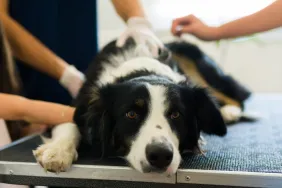This article is brought to you courtesy of the National Canine Cancer Foundation.
See more articles on canine cancer.
Donate to the Champ Fund and help cure canine cancer.
Description
Gastric cancer occurs in dogs mostly in the age group of 8-10 years or more. Though it is a very common type of cancer, it accounts for less than 1% of all malignant tumors. It can occur in any breed, but dogs which have been under the influence of nitrosamines (found in food stuffs preserved with nitrite pickling salt) over a prolonged period are believed to be more susceptible to the disease. Recent studies have pointed out that German Shepherds have a higher incidence owing to genetic factors.
Types of gastric Cancer
The different types of gastric cancer are adenocarcinoma, lymphoma, leiomyrosarcoma and mast cell tumors.
Adenocarcinoma
They are type of tumors most often associated with cancer of the stomach. This cancer is one that is found in glandular tissue. It accounts for 70-80% of all malignancies. This type of cancer originates in the stomach wall and spreads to the gastric lymph nodes, omentum (fat on the bottom edge of the stomach), liver, oesophagus, adrenal glands, lungs, duodenum (first part of the intestine), pancreas and spleen. In some bizarre cases, gastric carcinoma is believed to have metastasized to the testes. Gastrointestinal stromal tumors (GIST) also account for 20% of all gastric tumors.
Lymphoma
It is a type of cancer that originates in the white blood cells (leukocytes). It is a multicentric type of cancer that is unfortunately the most common. But gastric lymphoma accounts for 7-24% of all deaths caused by cancer of the gastrointestinal tract in dogs. Is it important to state that Lymphoma Gastric cancer is not the most common Gastric cancer and should not be confused with Lymphoma cancer with is one of the most common Cancer in dogs. It is more common in males than in females and occurs in the ratio 2.5:1.Breeds that have a predilection for the disease include Boxer, Saint Bernards, Mastiff, Airedales, Bull Dogs and Scottish Terriers.
Mast Cell Tumors
Mast cells are part of the immune system that responds to allergies and inflammations. They are present in the linings of the digestive tract, lungs, nose and skin. When these cells become abnormal they form mast cell tumours that release biological chemicals like heparin and histamine in excess. These chemical changes in the body cause damage.
Leiomyrosarcoma
They are type of tumors that are present on the walls of organs like stomach, bladder, uterus and the respiratory tract. They mostly metastasize to liver, spleen, kidneys and lymph nodes.
Symptoms
The symptoms an owner normally sees are vomiting tinged with blood, anorexia and loss of weight. Other symptoms include vocalization, licking or scratching of any part of the body, unhappy demeanour and body language, irregular urination and bowel movements. lt results from poor digestion, loss of blood and protein from the ulcer or generalized tumor cachexia. Duration of symptoms may vary from weeks to many months.
Treatment
When doctors take positive or double contrast gastric radiographs, the images reveal a mass lesion extending into the lumen. Other tests include Fluoroscopy that may reveal motility alterations. Ultrasonography also proves useful in this case. For detecting larger lesions that can be biopsied, oncologists go for gastrocopy with a flexible endoscope. Several large samples need to be taken because most of the tumors have superficial necrosis, inflammation and ulceration. Some tumors are also sub-mucosal in nature, making biopsy difficult.
Instances like microcytic hypochromic anemia and occult blood in the faeces may help the oncologists diagnose gastrointestinal cancer. In many a cases, the liver enzymes are elevated due to obstruction of bile duct because of the disease.
It is normally very difficult to assess which stage the cancer is in without evaluating the liver and all the abdominal lymph nodes. This can be done only through surgery. It could be either curative resection or wide partial gastrectomy or gastrojejunostomy followed by a gastroduodenostomy. Doctors try to avoid complete gastrectomy since the chances of survival are bleak. In some instances, the lesions become obstructive thus making surgery difficult. In these cases, doctors resort to palliative gastrojejunostomy to allow the passage of food into the intestine. Even this procedure is not bereft of its disadvantages, since the mortality rate is very high.
Chemotherapy generally begins one week after surgery to ensure that all the cells are killed. A common chemotherapy protocol is chemo (Adriamycin) every 2 weeks for 5 treatments and then weekly (Cytoxan chemotherapy, along with daily Doxycycline (for antiangiogenesis) and Piroxicam (immune support as a COX2 inhibitor) and monthly (Vincristine) treatments.
It may result in some stomach discomfort including upset stomach, diarrhea and vomiting.
Prognosis
Gastric cancer when diagnosed is usually at an advanced stage. Therefore the chances of recovery and prognosis are usually poor. The median survival in gastric adenocarcinoma is 2 months. In palliative bypasses it is between 1-6 months.
References
Withrow and MacEwen’s Small Animal Clinical Oncology – Stephen J. Withrow, DVM, DACVIM (Oncology), Director; Animal Cancer Center Stuart Chair In Oncology, University Distinguished Professor, Colorado State University Fort Collins, Colorado; David M. Vail, DVM, DACVIM (Oncology) Professor of Oncology, Director of Clinical Research, School of Veterinary Medicine University of Wisconsin-Madison Madison, Wisconsin
Hound Health – Betsy Brevitz, D.V.M.
Dog Owners Home Veterinary Handbook – James M. Giffin MD; Liisa D. Carlson, DVM
Canine Lymphoma: Protocols For 2004 – Gregory K. Ogilvie, DVM, DACVIM (Internal Medicine, Oncology)









